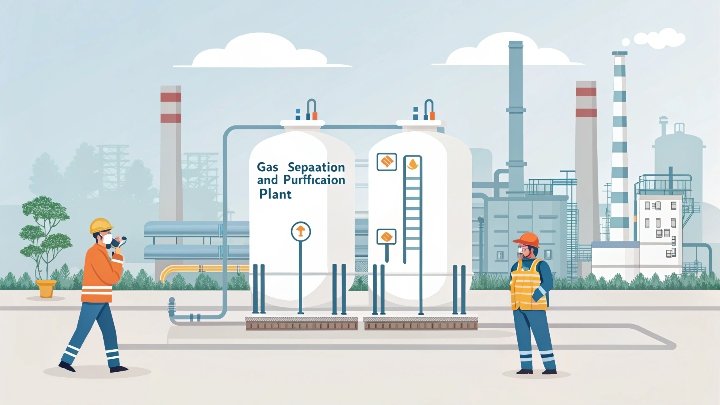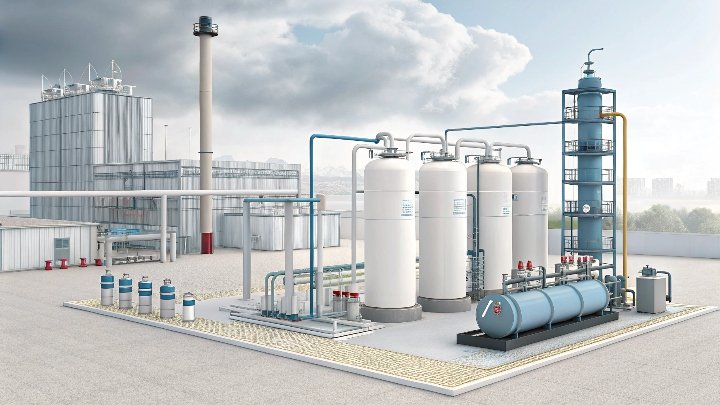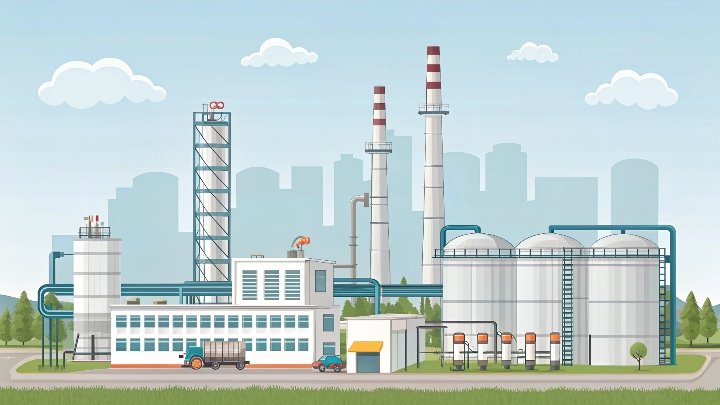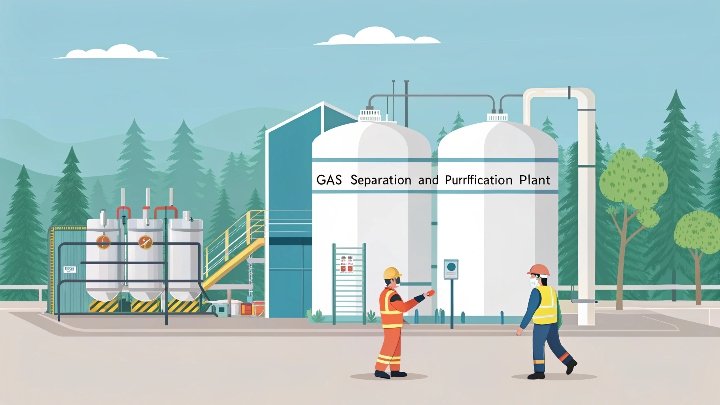I worry about lingering impurities in gas streams. I want to stop pollution and keep operations efficient. I turn to 13X molecular sieves to achieve these goals.
13X molecular sieves capture CO2, H2S, and other impurities, ensuring cleaner gas supplies and safer operations. They also offer versatile benefits in air separation, high-purity gas production, and pollution control. They reduce operational costs because they can be regenerated and reused.
I have used other adsorbents before, yet I keep coming back to 13X molecular sieves. Now, let’s explore why they work so well in different applications.
Natural Gas Cleanup: How 13X Sieves Save the Day?
I used to worry about the high CO2 and H2S levels in natural gas streams. I questioned if there was a simple way to make gas safer. Then I found 13X molecular sieves.
They remove CO2 and H2S from natural gas by selectively adsorbing these contaminants. This helps me deliver cleaner, safer energy with lower emissions. They are also cost-efficient because they can be regenerated, making them valuable in continuous operations.
Contaminant Removal and Economic Benefits
I have seen firsthand how natural gas suppliers face strict regulations. They must control CO2 and H2S. These impurities lower gas quality and can cause corrosion in pipelines. To solve this, I rely on 13X molecular sieves for precise adsorption. Below is a quick look at key advantages and challenges:
| Advantage | Challenge |
|---|---|
| High capacity for CO2 removal | Potential fouling by heavy hydrocarbons |
| Effective H2S adsorption | Requires periodic regeneration |
| Regenerable and reusable | Energy needed for desorption |
| Reduces pipeline corrosion | Correct design critical to avoid downtime |
Contaminant Removal
I focus on 13X sieves because they have a strong affinity for polar molecules like CO2 and H2S. This means they hold onto these molecules while letting methane pass. In my view, this is crucial. I want to meet environmental rules without losing valuable hydrocarbons. When I run a natural gas plant, I must balance purity, efficiency, and cost. 13X sieves allow me to do that.
Economic Benefits
I pay attention to the cost of ownership. Energy expenses add up if I have to do frequent regenerations. But 13X sieves can be regenerated at relatively moderate temperatures or through pressure swing approaches. This lowers costs over the long run. I see a direct impact on overall profitability. Fewer replacements mean fewer disruptions. Also, the reliability of 13X sieves boosts production consistency. My experience tells me that stable performance leads to satisfied customers and improved margins.
Because of these reasons, I find 13X molecular sieves to be a top choice for natural gas purification. They align well with my desire to deliver clean, efficient energy.
Air Separation Superpowers: Oxygen and Nitrogen on Demand?
I remember when I faced high demands for oxygen in medical facilities. I needed a tool that could produce high-purity oxygen and nitrogen. That is where 13X molecular sieves come in.
They target specific gases, allowing me to separate oxygen from nitrogen and other components. I get a steady supply of high-purity oxygen and nitrogen. This helps me serve healthcare, manufacturing, and other sectors with consistent gas streams.
Pressure Swing Adsorption (PSA) and Boosted Efficiency
I first encountered PSA systems that used 13X sieves to enrich oxygen levels. I saw how these systems pulled in air, compressed it, and then passed it through adsorbents to separate nitrogen from oxygen. Below is a simplified table of some insights:
| Factor | Impact on Air Separation |
|---|---|
| Adsorbent Selectivity | Affects purity of oxygen/nitrogen |
| PSA Cycle Time | Determines throughput and efficiency |
| Regeneration Method | Influences energy use and operating cost |
| Sieve Lifetime | Affects maintenance intervals |
Pressure Swing Adsorption Process
I like the PSA approach because it uses pressure differences to adsorb and desorb gases. At higher pressure, nitrogen binds to 13X molecular sieves, letting oxygen pass. Then at lower pressure, nitrogen is released, regenerating the sieve. Because of this cycle, I can keep producing oxygen almost nonstop. I appreciate how simple the system is compared to cryogenic methods. It is more compact and energy-efficient for moderate flow rates.
Boosted Efficiency
The success of PSA depends on selectivity. 13X sieves excel at differentiating nitrogen from oxygen. This leads to higher oxygen purity. I enjoy how it yields continuous production without a huge energy cost or expensive infrastructure. I have seen this approach used in clinics for medical oxygen, in manufacturing plants for specialized processes, and in food packaging operations that demand nitrogen to preserve freshness.
The ability to switch between oxygen and nitrogen production by adjusting cycle parameters underscores the versatility of 13X sieves. I consider it a game-changer for smaller operations looking for independence from bulk gas deliveries. Plus, because these sieves are durable, I replace them less often, cutting down on downtime and maintenance costs.
Eco-Warriors: 13X Sieves in Air Purification and Pollution Control?
I often worry about rising pollution levels. I ask if there is a cleaner, more sustainable path. I then discover that 13X sieves can capture volatile organic compounds and emissions.
They help me capture pollutants and harmful gases. By removing VOCs and reducing emissions, I protect the environment and help companies meet regulatory rules. Their regenerative nature makes them both cost-effective and planet-friendly.
 VOC Capture, Emission Reduction, and Sustainability
VOC Capture, Emission Reduction, and Sustainability
In my past projects, I saw how industrial plants emit a wide range of contaminants. This can harm air quality and human health. I rely on 13X molecular sieves to capture and hold onto these substances. Below is a closer look:
| Aspect | How 13X Sieves Help |
|---|---|
| VOC Capture | Adsorb harmful organics from exhaust |
| NOx and SOx Reduction | Trap pollutants from flue gases |
| Regenerability | Lower operating costs over time |
| Sustainability | Supports cleaner air and regulations |
VOC Capture
I focus on volatile organic compounds because they lead to smog and pose health hazards. 13X sieves can adsorb many organic molecules because of their structure and polarity. This means I can trap these pollutants before they escape into the atmosphere. I find this valuable for industries like painting, petrochemicals, and pharmaceuticals.
Emission Reduction
Some industrial processes emit acid gases like SOx or NOx. These can cause acid rain. I value how 13X sieves can selectively adsorb these gases. While they may not remove them fully in every application, they do reduce overall emissions. This is important to me because many regions have strict air quality standards.
Sustainability
I often think about the long-term impact of these solutions. 13X sieves can be regenerated using heat, pressure, or purge gas. This lowers waste and extends the sieve’s life. It also cuts down on frequent replacements. This is critical if I want to keep my environmental footprint low. I can reuse the same sieves many times. That means fewer raw materials used and less waste produced.
I have found that combining 13X sieves with other control devices, such as scrubbers, leads to even better results. The sieves remove targeted pollutants, and the scrubbers handle other residuals. In this way, I create a more holistic approach to air quality management. Over time, I have come to see that 13X sieves are not just cost-effective, but also environmentally friendly.
Conclusion
I see 13X molecular sieves as a powerful tool for gas separation, air purification, and cost savings. They protect the environment and support vital industries.






